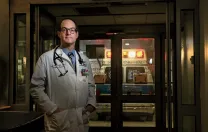One minute, she was sitting at her desk writing a document for a court deadline the following morning, and the next minute she was on the floor, gasping for breath, her body curling in on itself as pain raced through her spine like an electric current. This was late 1994. Kate Nicholson, J.D. ’92, was a young lawyer, a year and a half into a job with the Justice Department’s civil-rights division. That pain—profound, searing, unimaginable—would dominate the next two decades of her life. It would engulf her marriage and her ability to have children. It would keep her bedridden for long periods.
What helped was opioids. When the addiction crisis intensified, leading to a crackdown on prescription opioids, Nicholson found herself growing increasingly alarmed. No longer on opioids herself, she has begun speaking and writing on behalf of other chronic-pain patients who fear being cut off from the medicines that allow them to function day to day. “The pendulum has swung very far in the opposite direction,” she says. “The approach to prescription opioids has come off the rails.”
A growing number of doctors and researchers agree. In a 2017 study, for instance, Stefan Kertesz, M.D. ’93, an addiction researcher at the University of Alabama, wrote, “What caused the epidemic and what sustains it today…are not the same.” Doctors have reduced prescriptions even when it risked damaging their patient relationships, he says. “The period of late 2016-2017 included reports of pain patients subject to opioid termination who committed suicide, attacked physicians, died in withdrawal, suffered medical decline, or overdosed on illicit opioids.”
For Nicholson, the problem had begun more than a year before that first spasm of pain, with an operation to treat endometriosis, a disorder in which the tissue that normally lines the inside of uterus instead grows outside it. Her surgeon accidentally severed the nerve plexuses serving her pelvis, legs, and lower spine, and when the damaged nerves regenerated, they began firing spontaneously.
For a long time, Nicholson resisted taking opioids. She commuted to work while lying flat on her back in the rear seat of a car; in her office, she worked from a futon and got around using a walker; she argued cases in federal court from a reclining lawn chair. Meanwhile, her doctors tried different nerve blocks and infusions. They tried surgery to relieve the pain. Nothing worked. “Finally, they said, ’We’re putting you through all these miserable tests, and it’s our obligation not to make you worse.’ To do no harm, basically. At this point I was bedridden and would go for, like, five months without sleep.”
She started taking a high dose of long-acting opioids, supplemented with shorter-acting drugs whenever the pain intensified. The medicine enabled her to sleep again, and then to work. With the pain controlled, her mind cleared and her life opened up. Other treatments (including, later, a spinal-cord stimulator delivering low-level voltage to block the pain) also helped, and eventually her body began to heal. A few years ago, she tapered off the opioids. She began hiking again in Colorado, where she’d moved. In 2017, she flew to Germany for reconstructive surgery to correct damage caused by years of not bearing weight on her spine, the last step in a long journey back to relative health.
“Opioids have two faces,” she says. “On the one hand, they are the most powerful pain medicines we have. But it’s a serious medication.” A last resort. “Not something that should be given out easily.” But it does still need to be given out, she argues. “Serious pain is second only to bipolar disorder in suicide risk and risk of early death. It’s the number-one cause of disability in this country, the number-one cause of lost work, in general the number-one reason people go to the doctor.…And I think what’s happening right now with our overly restrictive public policy on prescription opioids is that both people in pain and people with opioid-use disorder are really paying the price.” She notes that although prescription rates have been falling since 2013, addiction and overdoses continue to climb. “Unless people have had some kind of personal connection with pain, it’s very easy to just say, ‘Opioids are bad and they should be outlawed, end of story.’”









